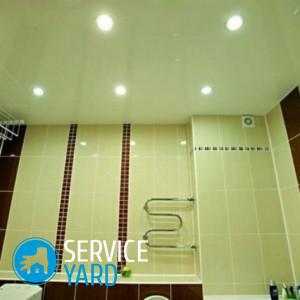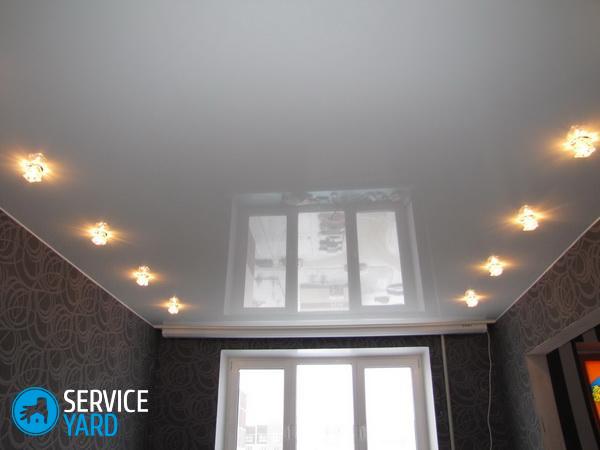What do they do first - stretch ceiling or wallpaper?

When repairing, it is equally important to observe accuracy, safety and sequence of actions. And if some of the questions are solved intuitively, for example, that the installation of the skirting board should be done after covering the floor, then the rest is difficult. Let's try today to decide what they do first - stretch ceiling or wallpaper? To answer this question, we will deal with the mechanics of the actions of two types of work.
to contents ↑How is wallpaper glued?
As we have already mentioned, consistency is important in repairs. No exception and pasting the walls. Before pasting, the necessary series of works follows:
- removal of the old coating;
- mold and mildew primer;
- putty cracks;
- plaster.
Consider the most important ones to answer our question, what do they do first - stretch ceiling or wallpaper, stages.
Alignment
First, the wall under the wallpaper must be aligned. Usually, plaster, putty or drywall sheets are used for this. But if the ceiling is already stretched, alignment is impossible, because:
- the risk of damaging a thin film when working with plaster is very high;
- the use of drywall is impossible due to the loose fit of the sheet to the surface of the ceiling and the inability to fix the profiles in the corners.
Accordingly - for a stretch ceiling you need already aligned walls. But a logical question arises: if the walls are even, and the coating is already stretched - is it possible to glue the wallpaper? To answer, we proceed to the second stage of work - the primer.
Grounding the walls
At this stage, there are also nuances:
- If the aligned wall is not treated with a primer - the wallpaper will very quickly take an unsightly appearance, and may completely fall off.
- The primer should be made over the entire surface of the pasting, and reach the ceiling.
Important! But if a tension coating is already used in the room, it is important not to stain it. This is real if you protect the corners with the wall using masking tape.
Next is the most important stage - the actual pasting.
Glue wallpaper
So, we are still in the process of searching for the answer to the main question: what to do first - to glue the wallpaper or stretch ceiling.
In order for the work to be successful, after the primer, the wall is smeared with glue. The strips of wallpaper can be glued dry, or processed, too - it all depends on their structure. To completely cover the wall with adhesive, you will have to contact the ceiling. Accordingly - you have two options:
- protect the coating again with masking tape;
- glue the wallpaper before stretching the ceiling.
Important! An additional risk of damage to the coating can be caused by fitting the picture and cropping the wallpaper when fitting it with a clerical knife. But if you work carefully - clipping wallpaper is possible.
The risks are clear, the work is reviewed. But we will also figure out how to install tension coatings.
to contents ↑Ceiling tension
It is customary to trust this type of work to specialists, because here you can not do without professional equipment and skills. First, recall what stretch ceilings are.
A bit about stretch ceilings
- Today, many people use stretch coatings for decorating ceilings: they are very easy to use, easy to install, non-toxic and easy to clean. You can simply wipe their surface with a damp cloth.
- The material for such coatings is a PVC film or fabric, which is stretched on a pre-fixed frame.
As a result, you should get a perfectly flat surface of your chosen color or even with a pattern. Let's go directly to the workflow.
Description of work
To start work, you must make sure that all walls are flat. Next, fasteners are installed.
Installation of profiles
The profile or mounting baguette is mounted in the holes drilled in the wall. At the same time, this moment will not affect the appearance of the wall covering, since the holes will be closed by fasteners. Accordingly - at this point in the issue, glue the wallpaper before or after the stretch ceiling, the wallpaper wins.
Next, the room and coating are heated using a heat gun.
Warm up
Experts believe that strong heating can damage already finished walls, and there is some truth to this. But you can damage the finish in other ways, for example, when installing furniture. Therefore, these fears are often not justified.
Important! To heat a vinyl sheet, a temperature of about 80 degrees Celsius is needed, at which the risk of damage to the walls is minimal. Of course, this is possible only if the master observes safety precautions.
Stretch
Today, professionals have different opinions and ways of conducting the workflow for stretching the coating. The conditions of the work and the premises play a role. But the logic of the work itself suggests that the best option would be to completely finish the wall first, and then pull on the PVC film.
Important! There is another aspect in defense of this sequence. The coating should be stretched in a clean room, and in the presence of construction debris, glue, paint, dust from wall repairs, all dirt will settle very quickly on your new ceiling.
Thus, we get two optimal options for pasting:
- Preferred - before starting work on the ceiling. So you get the most even and clean coverage.
- Less convenient is the implementation of all dirty work before stretching, installing the ceiling and finishing pasting the walls after. The advantages of the method are the preservation of the appearance of the walls, the effect of heat until the final work, and the ability to replace the wallpaper.
So, we found out that the question of how to glue wallpaper with a stretch ceiling - before and after, is very relevant even among professionals, since both types of work affect each other. When choosing a method, be sure to consult with specialists, because they pay attention not only to generally accepted schemes, but also to the nuances of the room.
In conclusion, we give some useful tips.
to contents ↑Recommendations
The first thing to remember during any repair work is that you do not need to save on material. Poor-quality wallpapers will surely quickly come in an unsightly appearance, regardless of the intervention in the repair process of the craftsmen by stretching the ceiling.
Speaking about quality, one should recall professionalism. Trust work only to trusted companies and craftsmen.
Other tips:
- If you plan to repair for a long time, then the best option is to first make the walls.
- If you use wallpaper for painting, then it is more reasonable to stretch the ceiling after completing all work with wallpapers, including painting them.
- In order not to contaminate the wallpaper while drilling holes for the profiles, use a drill and a vacuum cleaner together. So you remove most of the dirt.
- Mount the ceiling only after the walls are completely dry. This will minimize the risk of wallpaper being peeled off. The best option is to wait a week and then stretch. Usually it takes about a week to make the canvas, so take your time with the order and make it after pasting the walls.
- If you are very afraid of damaging the walls with a stretched ceiling, there is an option to cover them with film.
- When gluing wallpaper after working on the ceiling, remember that the wall in any case must be aligned and ready for gluing before stretching. In this case, it will not be possible to protect the ceiling with a film, but he can accumulate enough dirt on himself.
- Do not allow plaster on the ceiling surface. It is better not to plaster the wall to the very top.The risk of spoiling the ceiling with such work is very high.
- Aligning the walls using sheets of drywall with a stretched ceiling is impossible, because they require fasteners, and it is impossible to install them on a PVC film.
- On an uneven wall, the fasteners will not fit snugly - the coating may warp or sag.
- Masking tape will help protect the coating when painting the walls, and you can hide the transition from the tape using border tapes or baseboards.
- If trouble nevertheless occurred and glue got on the coating, do not hesitate and quickly wipe the contaminated area with a damp sponge.
Some tips for care:
The ceiling coating is unpretentious, and repels dust itself. But there are times when you have to clean it. This is especially true for kitchen facilities.
You can clean the ceiling:
- Vacuuming without touching the cover itself.
- A soft, dry cloth or cloth.
- Clean the fabric cover with a soft brush.
- In order for the glossy coating to shine again, wipe it with aqueous ammonia in a ratio of 1: 9.
- If you need to clean the ceiling from stains, use warm water with a few drops of dishwashing detergent.
Important! Remember that any dirt is best removed as soon as it appears.
With a full decoration of the room, it makes sense to first make the floor and walls, glue the wallpaper, then stretch the film and complete the repair work, adding baseboards and other small details. If you doubt your actions or you have unsolvable questions - contact a specialist.
to contents ↑Stock footage
Whatever work order you choose, it is important to do everything with concentration and accuracy, otherwise, the risk of spoiling your repair will be very great. And after a successful experience it remains to admire the new ceiling and sometimes wipe it. Have a good repair!
- How to choose a vacuum cleaner taking into account the characteristics of the house and coatings?
- What to look for when choosing a water delivery
- How to quickly create comfort at home - tips for housewives
- How to choose the perfect TV - useful tips
- What to look for when choosing blinds
- What should be running shoes?
- What useful things can you buy in a hardware store
- Iphone 11 pro max review
- Than iPhone is better than Android smartphones



